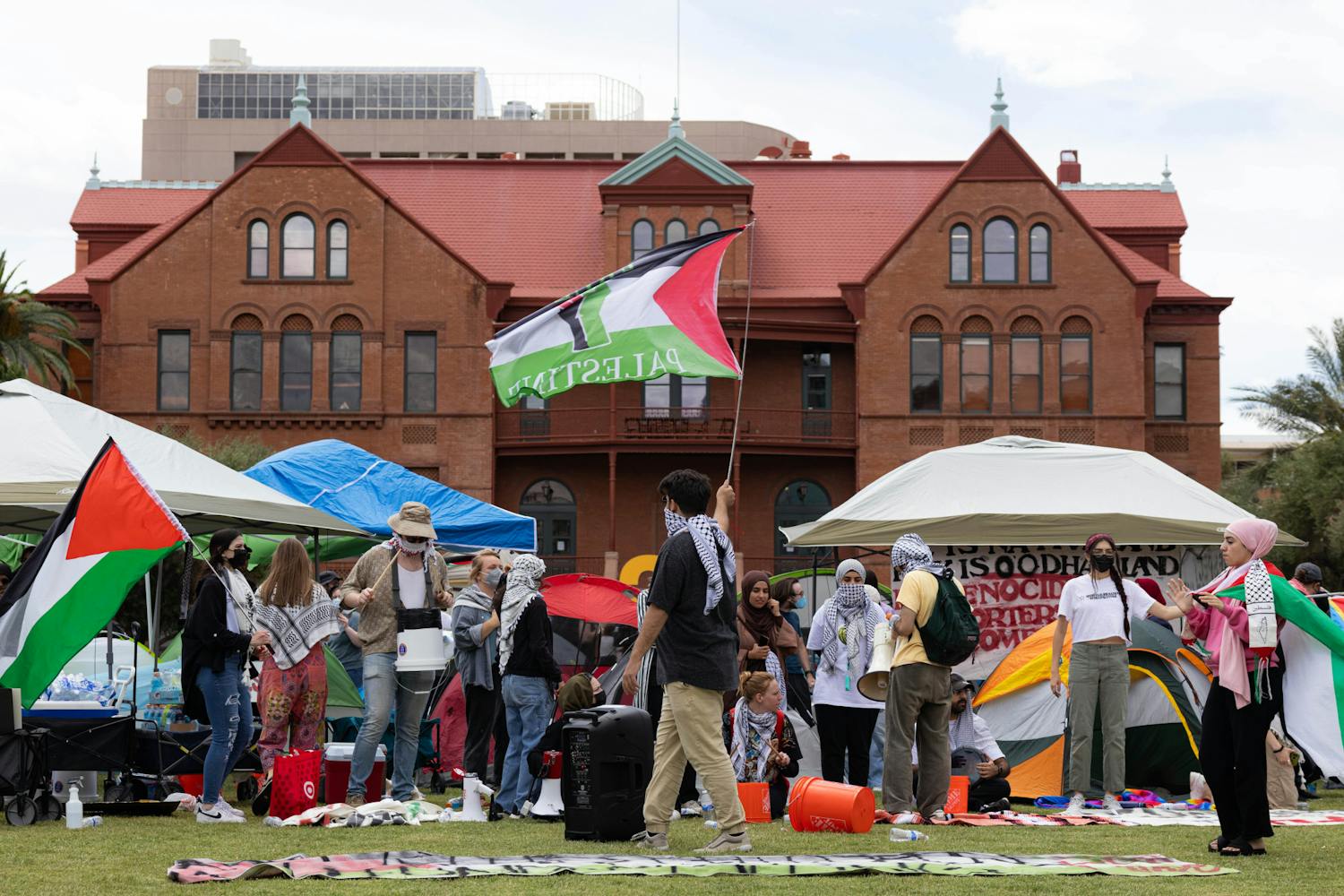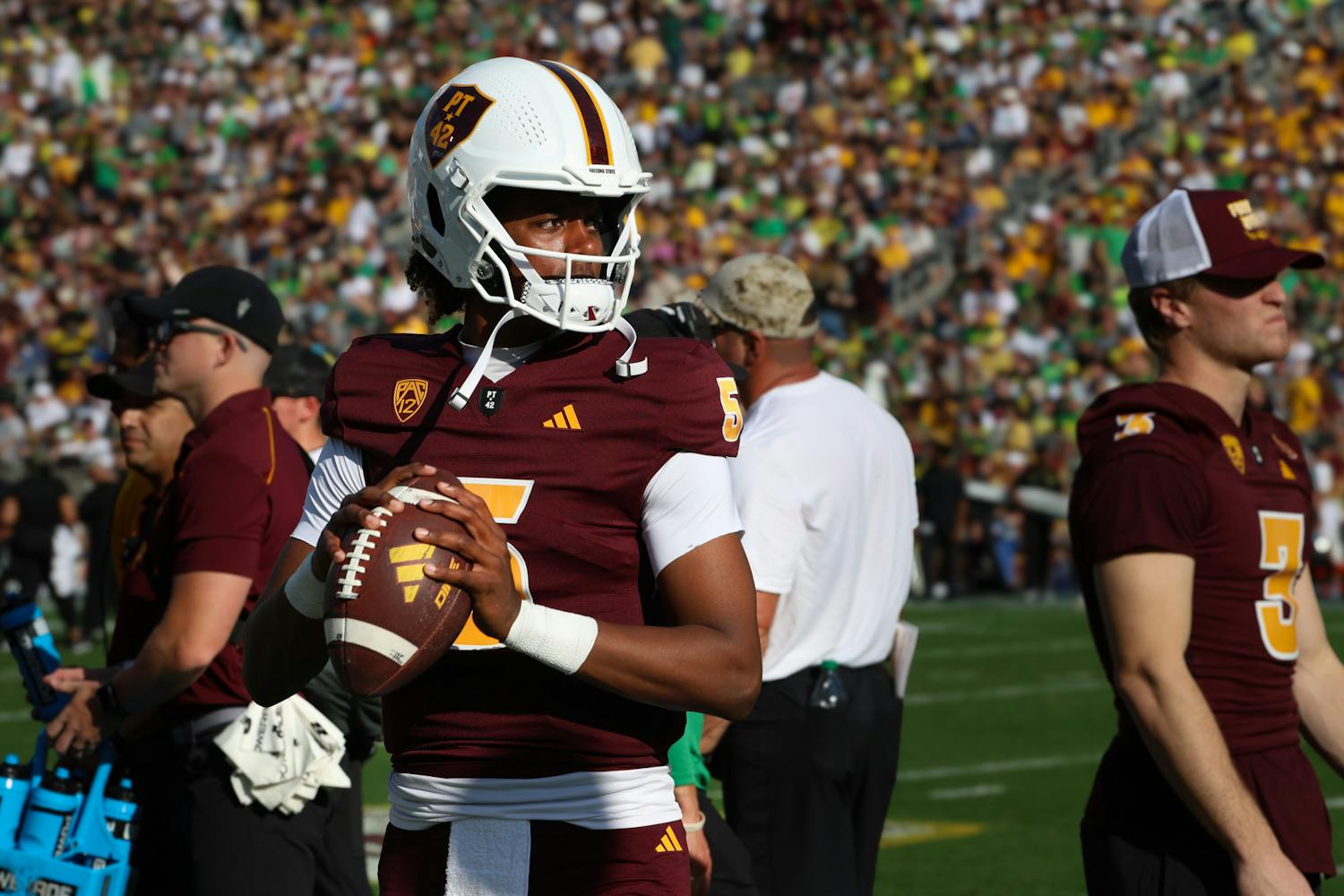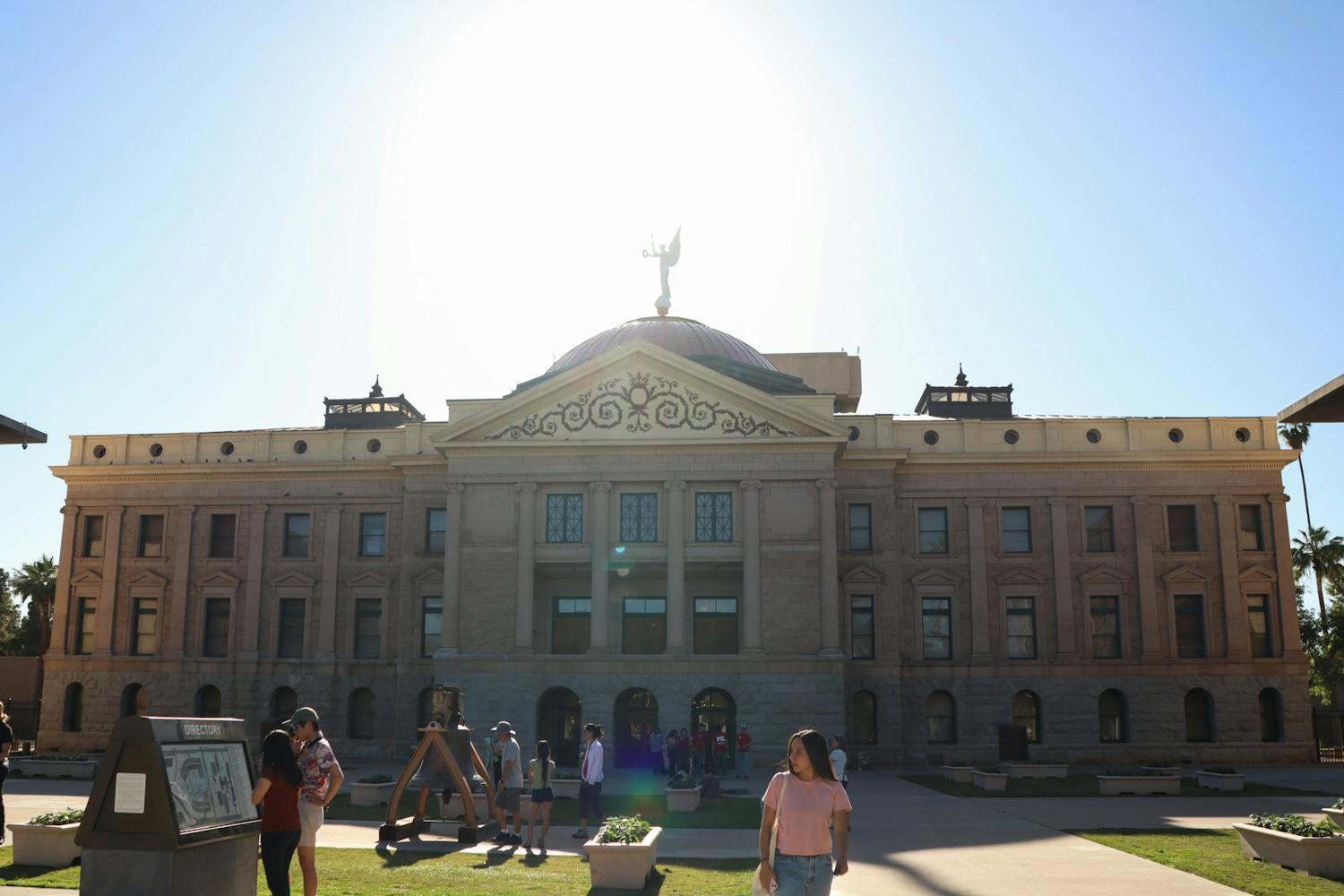Studio art is not generally thought of as a collaborative profession. For me, particularly, it conjures up an image of a person drawing for hours in solitude slumped over a surface illuminated by a dingy lamp, think, Ed Harris in “Pollock.” But, as seven ASU Fine Arts majors joined-up for their final exhibition, which ran from April 11-15 in ASU Gallery 101, seclusion was not one of the many themes conveyed.
“I Feel Weird,” featured works from Christine Beatty, Valerie Bullock, Ellie Craze, Nik Crawford, Molly Bridget Dean, Tovah Goldfine and Billy Rose, who came together to explore themes of self-doubt, identity, introspection and the subconscious through the use of various media.
As the seniors watched the last day of their final show approach, I sat down with them, individually, to reflect on their careers as artists thus far. Each was asked the same 10 questions, these are those questions:
SPM: Where were you born and raised? Where do you now call home?
Christine Beatty: I am born and raised, here, in Tempe, Arizona and I still call Tempe, Arizona my home. So, born and raised in the desert.
Valerie Bullock: I was born in Miami, Florida ‘cause there’s no hospital in Key Largo, ‘cause that’s where my family lived, but we moved here when I was 1. So, I was raised here by Florida people.
Ellie Craze: I’m a native Arizonan. I live here, I’m trying to leave though cause I’ve lived here for so long.
Nik Crawford: Well my dad when I was real young, like ‘til the age of 9, was in the military, so we kinda moved around a lot. I was born in Germany and moved back to the U.S. when I was real young. … I got married 3 years ago and we moved to Gilbert.
Molly Bridget Dean: I was born and raised in Mesa, Arizona, and to be honest and I don't think I've yet figured out where I'd call a home.
Tovah Goldfine: I was born in Scottsdale. My parents are from Minnesota though and I’ve been spending every summer in Minnesota since I was born.
Billy Rose: I was born in San Antonio, Texas, but I moved to Prescott, AZ when I was 3. So that was where I was raised. That was my weird home. I have a love hate relationship with that town. …I am married, so I guess home is wherever my partner is.
SPM: What is your preferred medium?
NC: Lithography is my preferred. It has the least limitations in my opinion. You want to draw something and have it look like a highly rendered drawing; you can do that with lithography. You want it to look real graphic and simplified; you can do that with lithography.
BR: In general, printmaking, of course. It depends on what the piece needs. I really really am enjoying screen-printing more than I thought I would. I came into printmaking through intaglio so it will have a special place in my heart.
CB: Photography, definitely, but I’m branching out more with this exhibition. I brought more installation work into everything. So, I’m starting to kind of experiment with that.
SPM: Describe your practice in a few words.
EC: Chaotic. I rarely think of good ideas when I’m in, like, a time of piece, I guess. I don’t know, schools obviously super chaotic and I’ve thought of some really great ideas while attending ASU…my work doesn’t necessarily read like that. I guess, it’s me finding an internal space and calmness through the chaos.
TG: Most of it is really organic. I don’t usually start with a solid idea but I let the image kind of manifest into what I can’t really say as eloquently as what I can view visually.
CB: It’s a personal experience I guess, so kind of my own personal interests and feelings. I identify very well with the title of “I Feel Weird.” So a lot of times, it’s me trying to describe a feeling I can’t describe. And, so, photography to me is a way to both replay moments as well as capture them in the moment.
SPM: Why did you decide to become and artist?
BR: I mean I just always did it and it was easier for my parents to buy me pencils and markers for my birthday than battery-operated toys. I was a science major in California and when we moved back to Arizona I decided I would take a drawing class. I took a printmaking course and decided, there’s no reason that I shouldn’t be doing this.
MBD: My dad, aunt, grandma, and cousin are artists, so I guess I've just always had the resources to explore visual arts. I also find I have a hard time feeling and expressing emotions and other fanciful abstract thoughts, and art helps me to do that.
NC: I guess it runs in the family in a sense. My grandpa was a full-time artist. He painted, he did a lot of screen-printing, he made signs. I don’t know if I necessarily believe in the whole, like, it’s in the blood sort of thing, but, I had some creative people in my life and that kind of, maybe, pushed it. From a pretty young age, I watched a lot of cartoons and drew a lot of cartoons because of that, and it’s never really left me I guess.
SPM: What are the best and worst things about getting a bachelor’s degree in fine arts?
VB: You really learn how to approach art in a more cerebral way and it’s a good way to expand your practice. But at the same time, there’s a stigma against fine arts degrees, like, “oh you can just learn art anyway,” but that’s not the point. It’s more about, you have to go, like, above and beyond to be able to really get what you’re trying to say across, and I feel like education is important to that so you can get more background on the stuff your trying to say.
TG: The best thing is being able to have these faculty mentors that are so renowned in their field and to learn from these people and to be able to use these facilities that I would have never had access to otherwise. And I think the worst thing is that I’ve chosen to pursue a dying art and there’s not a lot of job opportunity there unless you make it for yourself. So being an art student is really also learning to be an entrepreneur.
NC: I don’t know what other people not in the art community feel about it, like oh it’s the slacker’s degree. I feel like that’s a total sham. It’s the hardest I’ve ever worked, ever, and it’s just very very late nights, very very early morning, a lot of stress. These are very personal pieces. You put a lot of yourself into it and then you put it out there for other people to see.
SPM: Describe what it was like preparing for this show.
BR: It is, like with a lot of my work, there is so much incubating time and so the actual execution is a fraction, a tiny fraction, of the time it actually takes to, kind of, have your artistic epiphany. So once the idea is there, the work comes quickly. The hardest part is seeing what it should be before it exists.
EC: It was euphoric and then, terrifying, because we had one of the later exhibition dates. We had until, like April, you know. And we were just kind of havin’ a good time at first and then as it started getting closer we all started panicking because we thought we had way more time than we did. But it was also really great to work with all these people because we didn’t really know each other at all beforehand and now they’re pretty close to me.
MBD: Stress, terror, and sobering. Stressful to put together and hang up, terrifying to feel so exposed, sobering when receiving feedback. I also hate the expectation of “first impressions” and find that this makes the entire experience to be nerve wracking.
SPM: How did you determine which pieces made it in and which ones didn’t?
MBD: When I completed them, I felt very confident in which ones would go up. It's kind of like when you meet someone and think, "This is someone I'm going to go on a lot of crazy adventures with, possibly for the rest of my life." That's the feeling I got from the pieces I hung up for the show. They were also the same pieces where professors have said, “Wow. What the hell happened while I was gone? You grew some balls.”
NC: Well, for the past, like, year-and-a-half, maybe two years, I’ve been working with that same theme of trying to communicate with my stepson. So a lot of the pieces I have, virtually all of them fit that vein. And, what I ended up trying to look for was a good mix of mediums. Lithography is my favorite but I wanted to try to get a little bit of everything in there as best as I could. I’ve had my son actually do some of the art for some of them and I wanted to make sure those got in.
TG: I tried to pick a body of work that was the most cohesive. Part of printmaking is that you make multiples, so it wasn’t that difficult to find the pieces that went together because I had already made them together. But the way I decided that this specific series should go up is that it just seemed the most finished and… honest.
SPM: Do you have a favorite piece, if so, which one?
VB: I have two favorites: my first one is that larger “Altarspace,” this is my first print and my last print I just did is a triptych. I feel like they’re closest to what my mind’s eye sees.
EC: Definitely my most recent oil painting, it’s called “In Heaven Everything is Fine,” and I really enjoyed making that one because I’ve been making these fictional landscapes in various mediums. Like, I started with just marker and ink and then watercolor and now I’m on to oil with it. So I feel like it’s the most fully fleshed out my landscapes have looked so far.
MBD: My favorite piece is the one of the duck, named, "Lost." I honestly felt I did a good job at presenting the feelings I wanted to express for the piece. I have a recurring dream that I'm this duck in Africa and I fly away from my flock out of fear and curiosity, only to be lost and left for dead. It feels so real that I wonder if it actually happened, and anyhow, I relate to the duck. I definitely feel like curiosity has driven me to a point of no return in terms of emotions and intimacy.
SPM: How do you know when a work of art is finished?
BR: That’s a great question. Sometimes I don’t. Sometimes I’ll let other people tell me. I have changed pieces after they’ve sat for two years because they don’t mean the same thing anymore or I feel like they could be more impactful. So I guess a piece of work is finished when I don’t need it anymore.
TV: I guess I don’t. You don’t know, until you know. That sounds silly but when you look at it and you know it’s finished, that’s when it’s finished. I can definitely tell when something’s not finished a lot easier than when I can tell something’s finished.
CB: With photography, it’s more of deciding when the whole process is done because there’s a lot of small decisions, like do I need to take more pictures? Do I need to edit it more? But mostly, it’s when is the series done?
SPM: What are some works of art or artists that inspire you?
VB: I mostly just follow a lot of Instagram artists. There’s one, Oliver Hibert comes to mind, all of his work. He does a lot of similar clouds and rainbow stuff. Lisa frank is a solid childhood inspiration. Mostly I find a lot of inspiration in popular culture and cartoons and that sort of thing.
BR: The reason I enjoy printmaking is probably because of the German expressionists, they’re very influential for me, the Die Brucke group. I really love the etchings of Rembrandt and Goya and since etching was the reason that I started printmaking those are pretty special to me. I am not super taken with any contemporary print makers, by their work, and I think that’s probably just my own… not being able to enjoy this time. So a lot of my favorite artists are artist of the first half of the 20th century. I really enjoy modern art and all the baggage that came with that… and all the terrible people that made it.
EC: That’s a hard question. I’m really into the surrealist movement. So Magritte, Rene Magritte, he’s an inspiration of mine. And also the cliché, Salvador Dali. But, I find their styles really great because they incorporate imagination, interesting concepts, and a realistic, natural painting style. So I do try to incorporate all of those things in mine also. But I would say their work is much more surrealist than mine. I definitely try to keep it on the more bright and less dark side of that. So I also identify with the movement called pop-surrealism because, you know, it’s all like fun and fluffy and cotton candy, but it’s also like really weird and strange. One more artist that I admire, his name is Mark Ryden, he’s almost like the father of pop-surrealism and he does these crazy portraits and weird landscapes, but they’re all in this, like, weird dark palate.
Responses were trimmed due to space.



